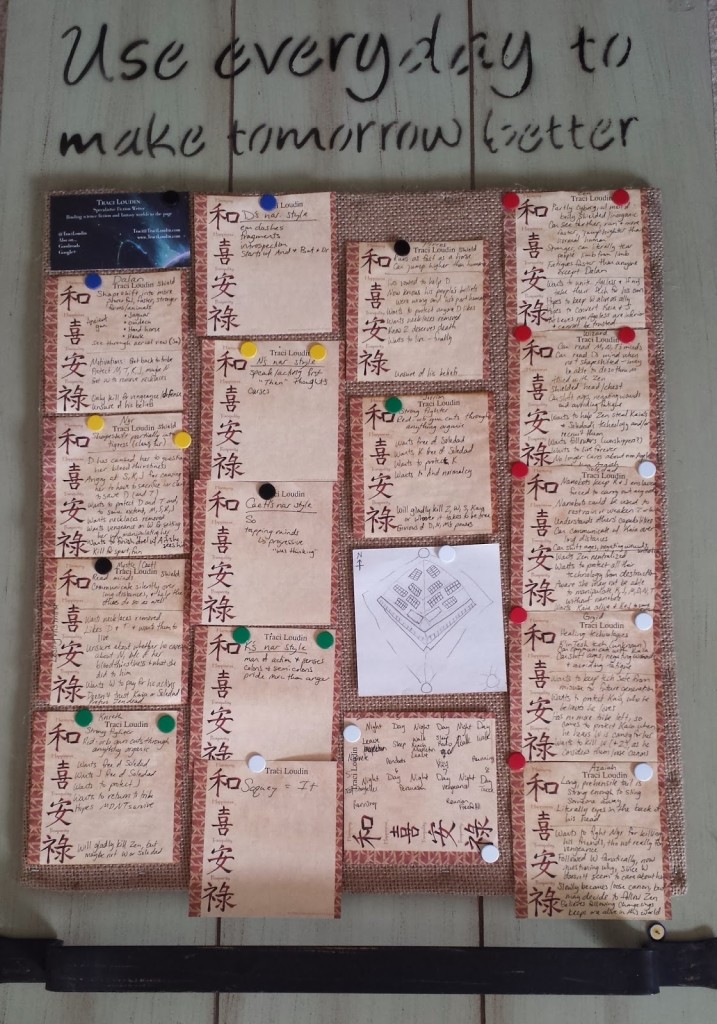A while ago, I talked about how I scoured the Internet for tips on self-editing a novel and concluded that three passes made sense. Today I’m back to share a checklist for revisions. (See the first pass here.)
Tomorrow, I’ll send the first five chapters of The Ageless off to my beta readers, which means I’ve already done most of the second and third passes on those chapters. I’ll talk more about the third pass in March.
The Purpose of Dividing Self-Editing Into Passes
 As a copyeditor in my day job, I’ll be the first to admit that no one can truly self-edit. You’ll need outside eyes to spot all the errors your brain skipped. Dividing your editing into three passes can help you focus and avoid missing obvious things. (Though you’ll still need actual editors, of course.)
As a copyeditor in my day job, I’ll be the first to admit that no one can truly self-edit. You’ll need outside eyes to spot all the errors your brain skipped. Dividing your editing into three passes can help you focus and avoid missing obvious things. (Though you’ll still need actual editors, of course.)
Additionally, it doesn’t make sense to polish up your prose on the sentence- and word-level when you haven’t finished slicing and dicing the scenes and chapters yet. During my first pass, I deleted at least three chapters, rewrote several chapters from scratch, and even added a few new ones. Polishing the prose on any of those beforehand would’ve been a huge waste of time.
So the first pass was for major story arcs, story structure, escalating tension, character development, etc.
That’s my revision board to the right. I do big revisions on the computer, and most of my notes are also on the computer. But sometimes, I have to think in ink.
Revising a Novel: Second Pass
Every writer is different, so what I’ve listed here may be part of your first pass or thirteenth pass. But if you’re trying to find a place to start, this may help. For me, there was some slight overlap between Pass 1 and Pass 2.
- Setting:
- Establish where and when at the beginning of the scene
- Add refreshers throughout so the setting doesn’t fade
- Portray setting from the character’s POV
- Sensory details:
- Help your reader experience the scene
- Try to use at least three senses
- Dialogue:
- Read dialogue out loud
- Make it unique to the character with diction, cadence, etc.
- Internal voice: Match internal monologue to their dialogue style
- Character:
- Realism: Is this really what this char would do?
- Realism: Does this seem out of char?
- Development: Their arc should continue compared to past/future scenes
- Voice: Their voice should be unique
- Style: The narrative style should change depending on POV char
- Viewpoint:
- Establish viewpoint character in first line of scene
- If third person, avoid sliding between limited and omniscient
- Watch for POV violations (viewpoint character knowing another character’s motivation)
- Emotion:
- Show emotions through actions
- Make motivations clearer through emotions
- Foreshadowing: Add where necessary to support later events
- Repetition: Avoid saying the same thing multiple ways or times on the word, sentence, and paragraph levels
- Metaphors:
- They have to match, noun and verb
- Example: A ball doesn’t bloom, so a “ball of fear blooming in his chest” doesn’t work
- Consistency of story terminology
- Example: Changeling vs. transmelder
- Example: Unstained vs. Purebreed
- Exposition:
- Overload: Is all this info necessary right now?
- Consider trimming down or cutting internal monologue
- Show, don’t tell (but don’t go overboard)
- Tell when it makes more sense than showing
- Eliminate exposition in the middle of the action — there’s no time!
- Tone: At the end of the scene, ask yourself if it invoked the right emotions in the reader
The examples above are from early drafts of The Ageless. The checklist itself is inspired by suggestions I found on the sites below, my own hurdles (problems that kept cropping up), and feedback from my wonderful critique partners on what I should improve. For example, I often added way too much internal monologue during fight scenes, which would slow down the action.
Along the way, I’ve learned that writing the novel is quite possibly the easiest part. Revisions take time. I toiled over the first pass for an entire year, which you can always see on my writing calendar. I’m hoping future books will go a lot quicker!
Resources for Revising a Novel
- The Emotion Thesaurus
- The Creative Penn: What Happens After The First Draft?
- Fictorians: A good beginning
- Fictorians: Why Revising Is A Good Thing
- Holly Lisle: How To Revise A Novel
- Magical Words: How To Revise A Manuscript Or Story
- Michael A. Stackpole: 7 Traits Of Enduring Characters
- SFNovelists: The Skill List Project: Rewriting
- Writer Unboxed: A Simple Approach To Revisions
- Writer’s Digest: Create Powerful Imagery
- Writing Excuses Podcast: Revision Episodes
Are you in the throes of editing a novel? Leave a comment below or find me as +Traci Loudin on Google+, the perfect place for writers of science fiction and fantasy to hang out.
Comments
3 responses to “Self-Editing: Second Pass”
[…] haven’t gotten to the second or third passes yet, so for this post, I’ll talk about what I’m looking for in the […]
[…] A while ago, I talked about how I scoured the Internet for tips on self-editing a novel and concluded that three passes made sense. Today I'm back to share a checklist for revisions. (See the first… […]
Thanks for the great tips!